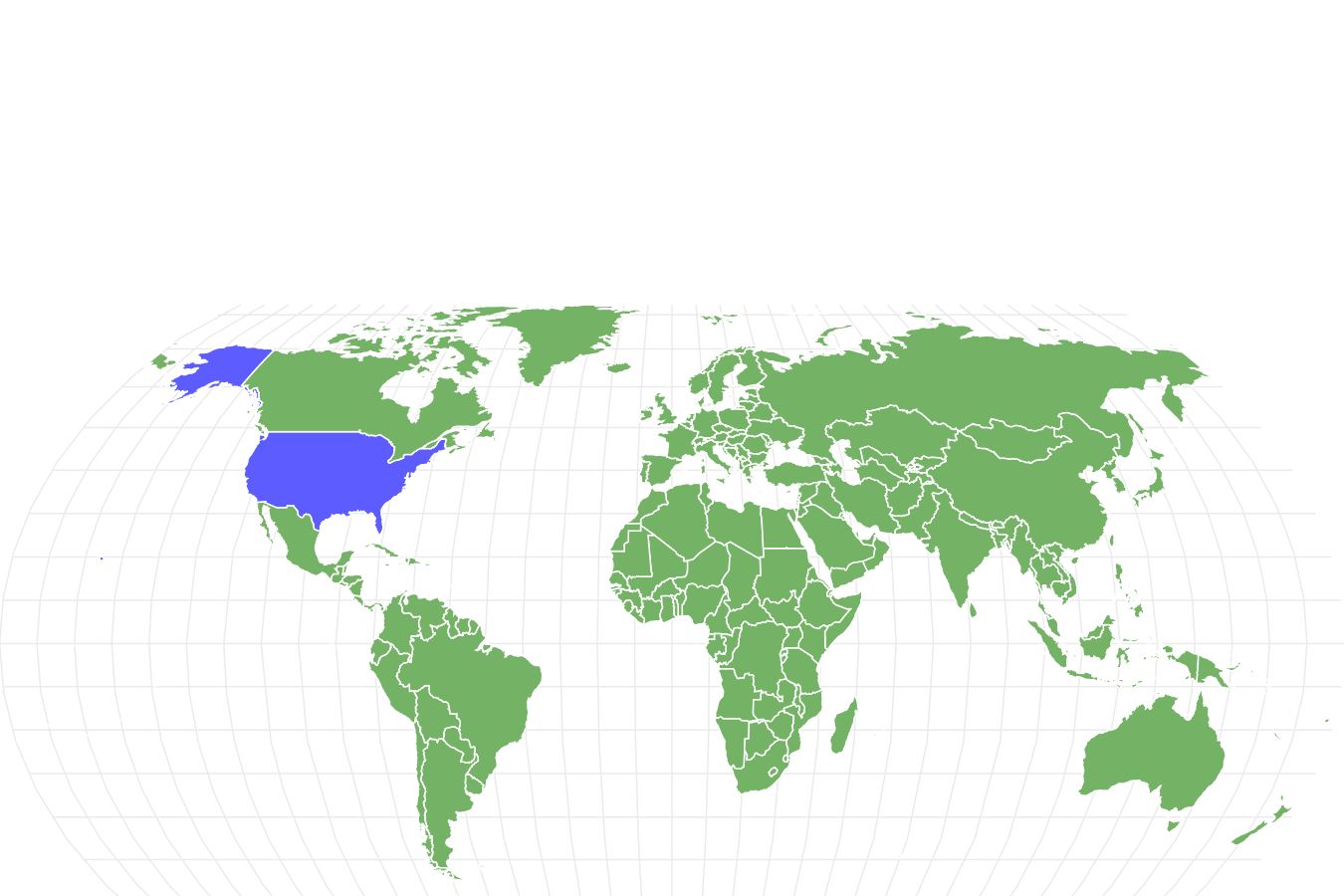Yellow Sac Spider
Primarily Carnivorous, but sometimes snacks on nectar.
Advertisement
Yellow Sac Spider Scientific Classification
Yellow Sac Spider Facts
- Prey
- insects, other spiders
- Name Of Young
- eggs, spiderlings
- Fun Fact
- Primarily Carnivorous, but sometimes snacks on nectar.
- Most Distinctive Feature
- translucent body with darker feet
- Other Name(s)
- Blackfooted Spider
- Gestation Period
- 4-6 months
- Litter Size
- 5 egg sacs per nest, 40 eggs each
- Habitat
- gardens, foliage, wood and debris
- Diet
- Carnivore
- Type
- arachnid
- Common Name
- Yellow Sac Spider
- Location
- North America
View all of the Yellow Sac Spider images!
A Yellow Sac Spider is a beneficial species native to the United States where it is found primarily in the northeastern to midwestern states.
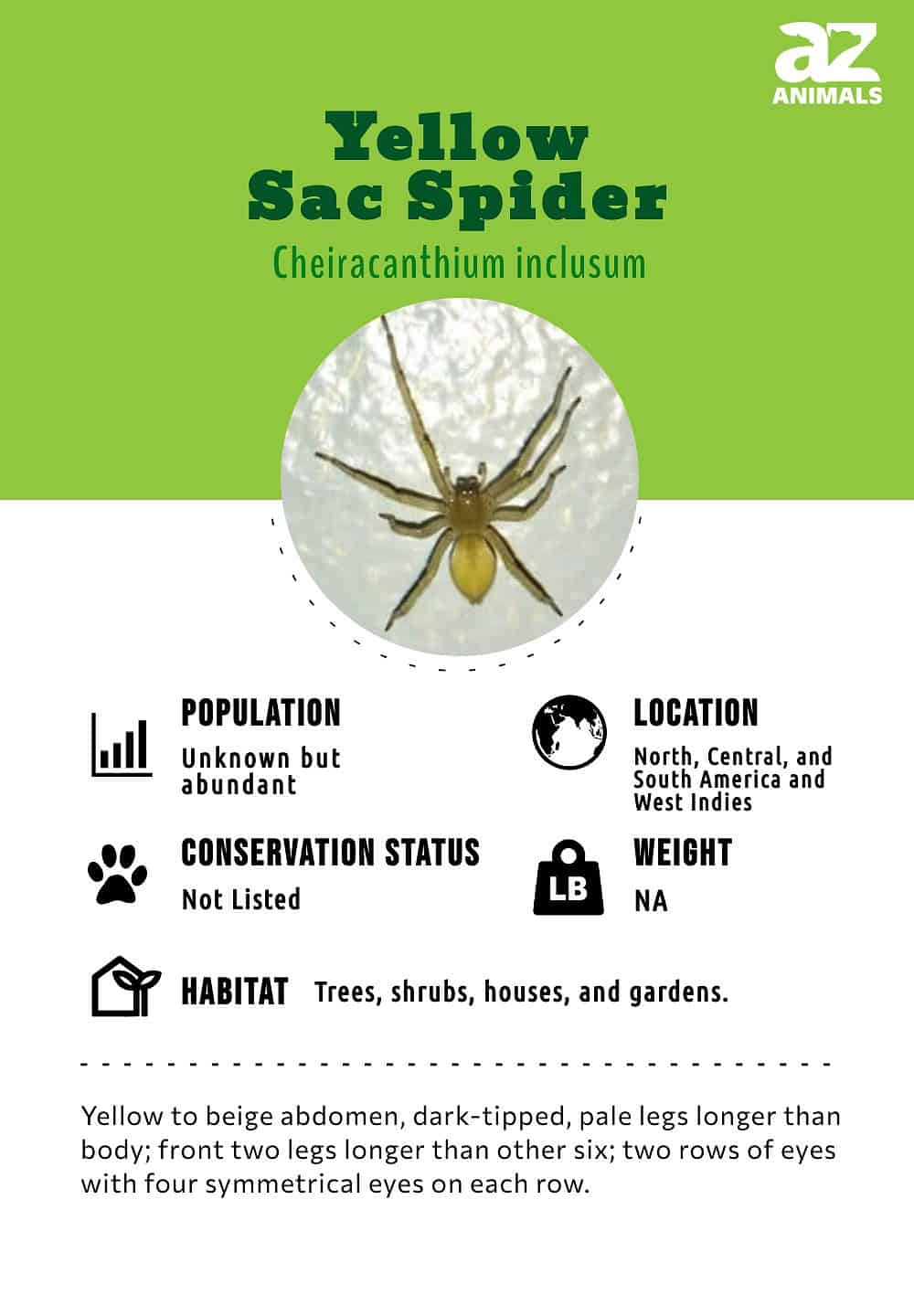
Similar species to the American version are found in many countries around the world including Germany and Australia. These spiders are active hunters who do not wait in a web for prey to come to them, but rather go out in search of food. They are nocturnal, so they do build small “sac” webs or nests in which to rest during the day.
2 Amazing Facts!
- Yellow Sac spiders are fast runners because they chase instead of catch prey, and they are fast at building their sacs in comparison to the speed at which other spiders build webs.
- Yellow sac spiders are among one of the few species of spiders that are considered to be medically significant; that is, they are of concern because of their venomous, albeit non-lethal bite.
Species and Scientific Names
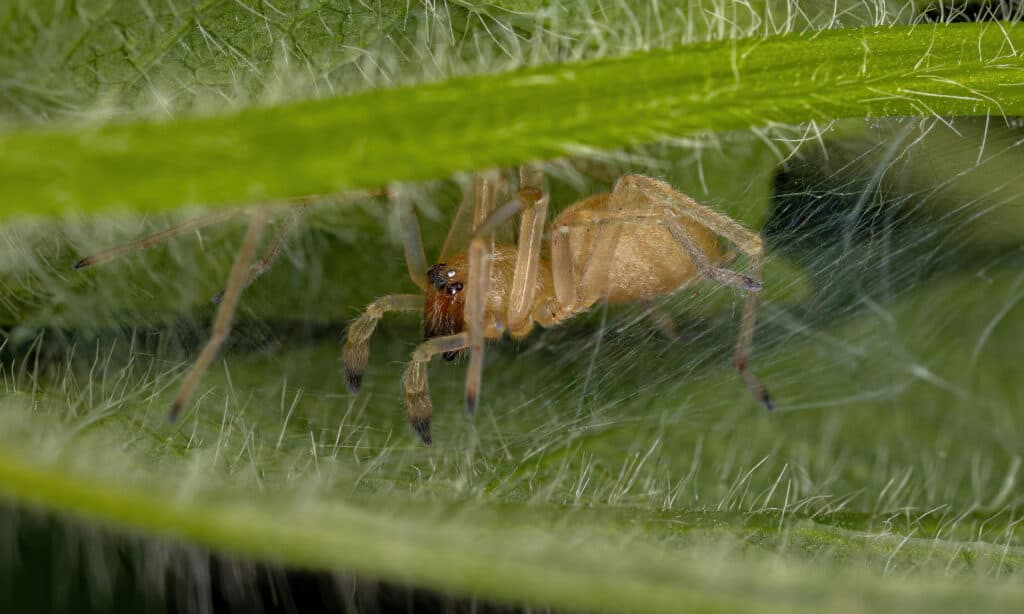
The black-footed yellow sac spider builds a silk sac to protect itself from predators during the day
©iStock.com/ViniSouza128
There are two species of Yellow Sac Spider in the United States. Cheiracanthium inclusum is the scientific name for the native species of Yellow Sac Spider, although this was not always the case. Originally, it was placed in the Clubionidae family, and then later the Miturgidae family, before finally being labeled as Cheiracanthiidae.
C. mildei is the other species found in the northeastern U.S. and eastern Canada. It is native to Europe, North Africa, and Central Asia, but it was introduced to North America, possibly by early colonists. C. punctorium is another species of Yellow Sac found in Europe.
Appearance
The name of this spider comes from its yellow or yellowish beige color and the fact that its web is not really a web but a sac-shaped place for resting instead of for catching prey.
A Yellow Sac’s size ranges from .2 to .4 inches, so it is small. Its legs are significantly longer than its quarter-inch body. The front two legs will be longer than the other six legs. They are typically very pale, sometimes even bordering on translucent, and the tips of their legs are much darker than the rest of their legs.
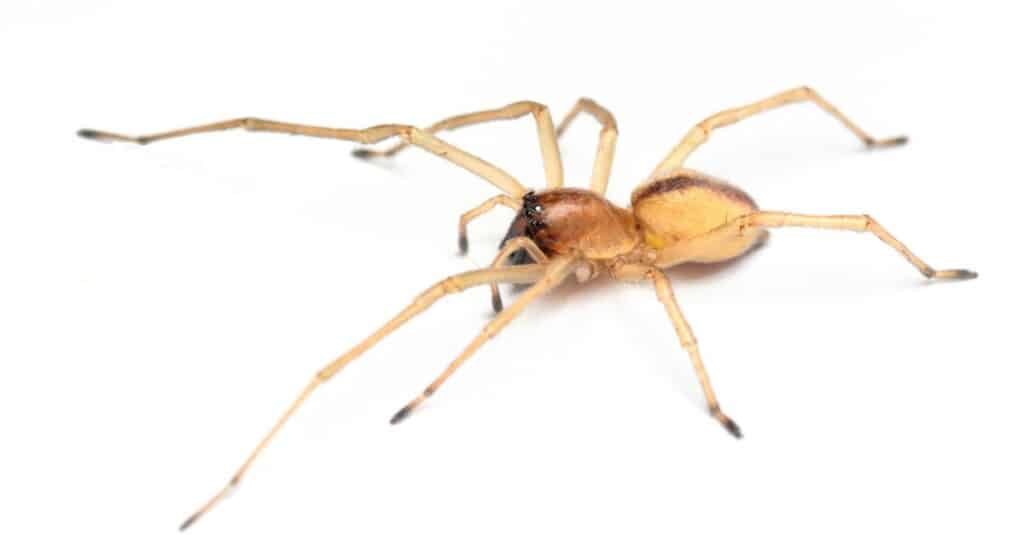
The Yellow Sac Spider often has a stripe down the middle of its back as this one does.
©D. Kucharski K. Kucharska/Shutterstock.com
Yellow sac spiders have two rows of eyes, with four symmetrical eyes on each row. They tend to have a stripe from the middle of their body to the back, but this can be hard to see on some colorations.
Behavior
There is some fear of these spiders because Yellow Sacs have been known to bite humans; however, there is little cause for alarm when encountering or even being bitten by a Yellow Sac Spider. Although they are somewhat venomous, mildly aggressive when provoked, and their bite can, in extremely rare cases, create necrotic tissue, Yellow Sac Spider venom is nowhere near as potent as that of a Brown Recluse and is not remotely potent enough to be fatal to humans. There is actually only one documented case of a Yellow Sac bite causing necrotic tissue.
Habitat
Yellow Sac Spiders can be found in the woods and in homes and gardens. These spiders are hunters, but they tend to stick within a few yards of their resting webs. They like to make these under woodpiles and yard debris, behind clutter, and around baseboards. Inside the home, they like dark, damp places with lots of places to hide and prey to hunt.
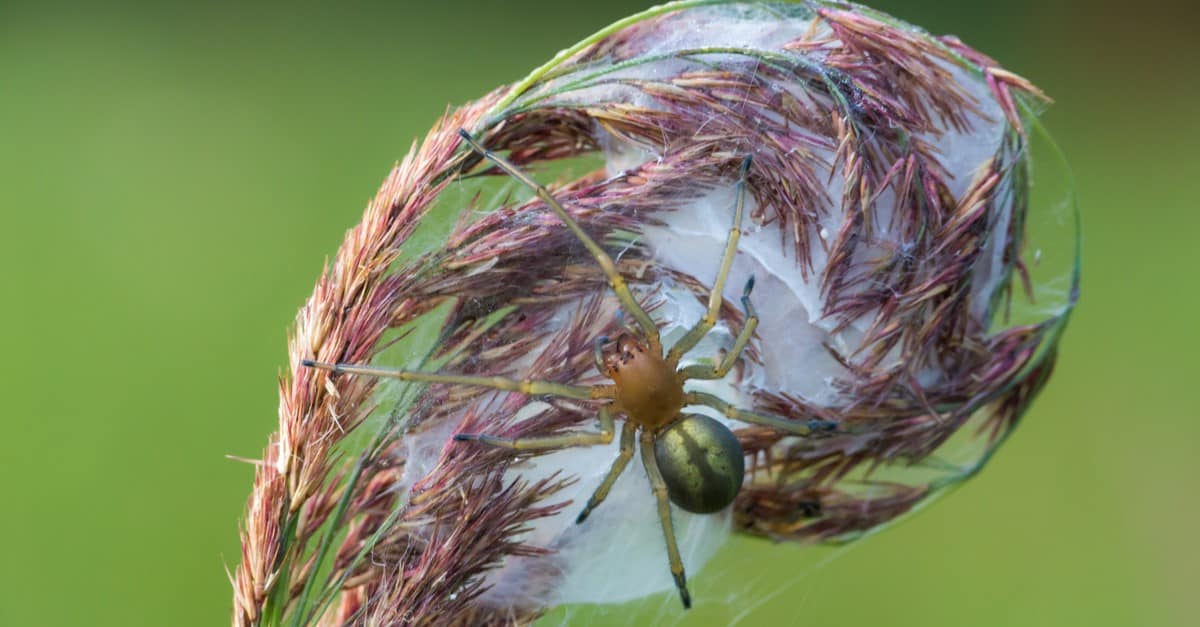
The yellow sac spider tends to stay within a few yards of its resting sac, like the one pictured here.
©Rainer Fuhrmann/Shutterstock.com
Diet
Yellow Sac Spiders are carnivores, although they will occasionally drink nectar. They enjoy hunting insects that we normally consider pests, including cockroaches and insect eggs. They will also eat other smaller spiders and, when resources are limited, will even consume their own egg sacs.
Prevention
Positively identify the Yellow Sac Spider using the tips listed above. Do not get close enough to allow the spider to bite you because they are aggressive when bothered.
- Inspect the property: pay attention to gardens, wood piles, basements, and closets to determine if there are multiple spiders in or near the home. Look for tunnel webs containing egg sacs.
- While wearing protective gear like gloves, mask, and long sleeves, remove any debris or clutter where spiders were found. Remove any children or pets from the home or move them to a safe room, away from the treatment area. Apply Bifenthrin-based insecticide treatments to gardens, foundations, baseboards, and other areas where the spiders were located. For heavier infestations, put down glue traps to monitor for further activity.
- Prevent reinfestation by repairing torn window screens, sealing cracks and holes, and decluttering the home to reduce the chances they can reenter and to remove attractive places for them to seek shelter.
Bites
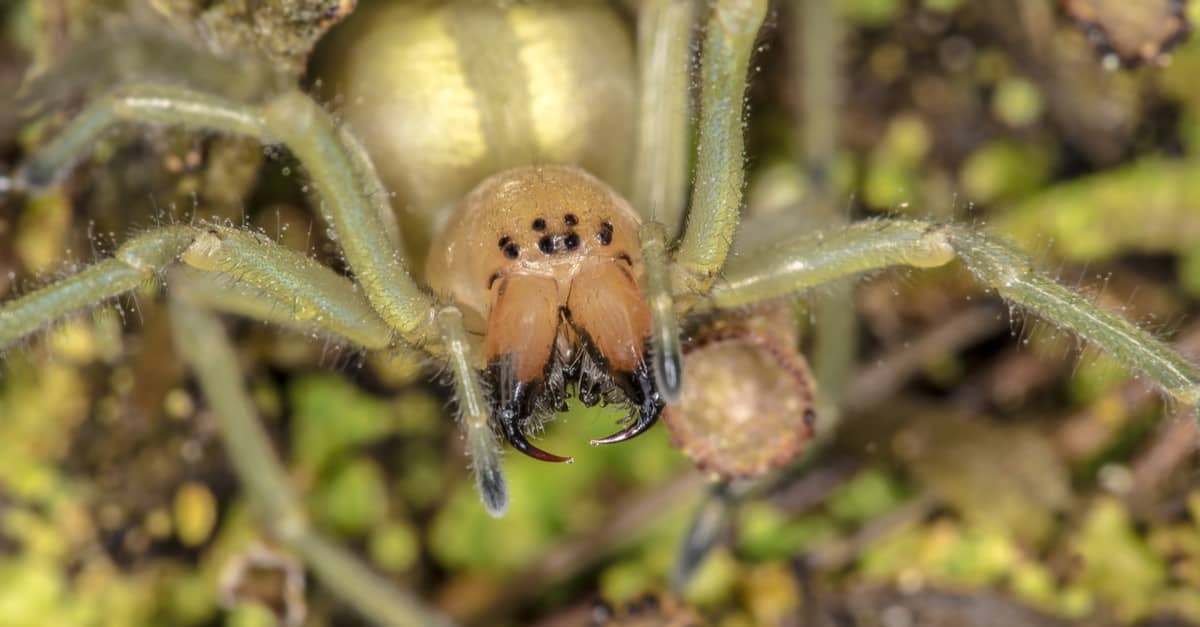
Yellow Sac Spider bites may cause redness, itchiness, and swelling.
©Rainer Fuhrmann/Shutterstock.com
A bite from a Yellow Sac Spider will most likely be red and swollen. Sometimes it is possible to see fang marks, but this is not common. As previously stated, Yellow Sac Spider bites are not deadly. If you are bitten, the bite may be quite painful for 90 minutes or so. After that, the most common symptoms will be redness, itchiness, and swelling. In some rare instances, the person may feel nauseated. There has been only one documented case of such a bite developing an ulcer, also known as necrotic tissue.
The most important thing to do if bitten by a Yellow Sac, as with any wound, is to keep the bite area clean and dry, perhaps with some over-the-counter antibiotic ointment and a bandage, to reduce the risk of infection. Recovery usually happens within just a few hours. If symptoms persist much longer than that, get worse, or in the unlikely event that the bitten person shows any signs of anaphylactic shock, seek medical attention immediately.
The easiest thing to do, if you live in an area where Yellow Sac Spiders are common, is to avoid a bite altogether. To do this, always wear gloves when gardening or picking up firewood or lawn debris, particularly in colder months. Shake out any clothing in closets that haven’t been worn in a long time. Keep your home as clutter-free as possible.
View all 32 animals that start with YYellow Sac Spider FAQs (Frequently Asked Questions)
Is a yellow sac spider poisonous?
No, they are not poisonous. Yellow Sac Spiders are venomous however, though their venom is very mild and unlikely to cause any lasting damage
Where do you find yellow sac spiders?
These are found from the American midwest eastward to the New England states.
Do yellow sac spiders jump?
Yes, usually as an aggressive scare tactic.
What does a yellow sac spider bite look like?
In some cases, there may be fang marks, but more likely it will be red and swollen. It will be easier to identify it by the pain and itchiness.
How do I get rid of yellow sac spiders?
Using a Bifenthrin-based insecticide and removing areas where they like to hide and make nests, such as clutter and debris is the easiest way, besides contacting an exterminator.
Thank you for reading! Have some feedback for us? Contact the AZ Animals editorial team.
Sources
- Kidadl / Accessed September 23, 2021
- wikiHow / Accessed September 23, 2021
- Big Blue Bug Solutions / Accessed September 23, 2021
- Animal Corner / Accessed September 23, 2021
- Wikipedia / Accessed September 23, 2021
- Beeline Pest Control / Accessed September 23, 2021
- Michigan State University / Accessed September 23, 2021
- Western Exterminator / Accessed September 23, 2021

